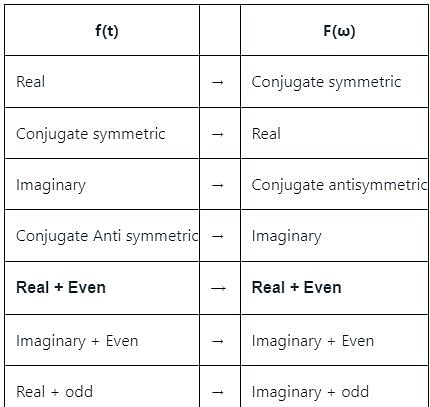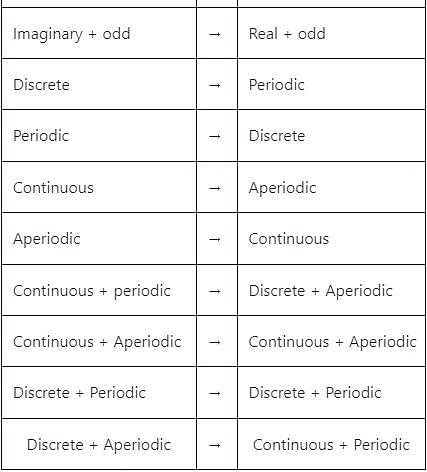Electrical Engineering (EE) Exam > Electrical Engineering (EE) Questions > In the Fourier transform, if the time domain ...
Start Learning for Free
In the Fourier transform, if the time domain signal x(t) is real and even, then the frequency domain signal X(jΩ) will be:
- a)imaginary and even
- b)imaginary and odd
- c)real and even
- d)real and odd
Correct answer is option 'C'. Can you explain this answer?
| FREE This question is part of | Download PDF Attempt this Test |
Most Upvoted Answer
In the Fourier transform, if the time domain signal x(t) is real and e...
Understanding the Fourier Transform of Real Even Functions
When analyzing the Fourier transform of a time-domain signal \(x(t)\) that is real and even, we can derive important properties about its frequency-domain counterpart \(X(j\Omega)\).
Properties of Real and Even Functions
- A real and even function satisfies the condition:
\[
x(t) = x(-t)
\]
- This symmetry in the time domain implies specific characteristics in the frequency domain.
Fourier Transform Definition
The Fourier transform of \(x(t)\) is defined as:
\[
X(j\Omega) = \int_{-\infty}^{\infty} x(t) e^{-j\Omega t} dt
\]
Evaluating the Transform
1. Substituting for Even Function:
- Since \(x(t)\) is even, we can express the integral as:
\[
X(j\Omega) = \int_{-\infty}^{\infty} x(t) \cos(\Omega t) dt - j \int_{-\infty}^{\infty} x(t) \sin(\Omega t) dt
\]
2. Properties of Cosine and Sine:
- The cosine term:
- \( \int_{-\infty}^{\infty} x(t) \cos(\Omega t) dt \) is real and even.
- The sine term:
- \( \int_{-\infty}^{\infty} x(t) \sin(\Omega t) dt = 0 \) (since \(x(t)\) is even and \(\sin(\Omega t)\) is odd).
3. Conclusion:
- Thus, the Fourier transform simplifies to:
\[
X(j\Omega) = \text{Real (even)}
\]
Final Result
Since \(X(j\Omega)\) is derived as a real function with even symmetry, the correct answer is:
- Option C: Real and Even.
This property is essential in signal processing and communication systems, as it helps in understanding the behavior of linear time-invariant systems.
When analyzing the Fourier transform of a time-domain signal \(x(t)\) that is real and even, we can derive important properties about its frequency-domain counterpart \(X(j\Omega)\).
Properties of Real and Even Functions
- A real and even function satisfies the condition:
\[
x(t) = x(-t)
\]
- This symmetry in the time domain implies specific characteristics in the frequency domain.
Fourier Transform Definition
The Fourier transform of \(x(t)\) is defined as:
\[
X(j\Omega) = \int_{-\infty}^{\infty} x(t) e^{-j\Omega t} dt
\]
Evaluating the Transform
1. Substituting for Even Function:
- Since \(x(t)\) is even, we can express the integral as:
\[
X(j\Omega) = \int_{-\infty}^{\infty} x(t) \cos(\Omega t) dt - j \int_{-\infty}^{\infty} x(t) \sin(\Omega t) dt
\]
2. Properties of Cosine and Sine:
- The cosine term:
- \( \int_{-\infty}^{\infty} x(t) \cos(\Omega t) dt \) is real and even.
- The sine term:
- \( \int_{-\infty}^{\infty} x(t) \sin(\Omega t) dt = 0 \) (since \(x(t)\) is even and \(\sin(\Omega t)\) is odd).
3. Conclusion:
- Thus, the Fourier transform simplifies to:
\[
X(j\Omega) = \text{Real (even)}
\]
Final Result
Since \(X(j\Omega)\) is derived as a real function with even symmetry, the correct answer is:
- Option C: Real and Even.
This property is essential in signal processing and communication systems, as it helps in understanding the behavior of linear time-invariant systems.
Free Test
FREE
| Start Free Test |
Community Answer
In the Fourier transform, if the time domain signal x(t) is real and e...
Let F(ω) is the Fourier transform of f(t).




Attention Electrical Engineering (EE) Students!
To make sure you are not studying endlessly, EduRev has designed Electrical Engineering (EE) study material, with Structured Courses, Videos, & Test Series. Plus get personalized analysis, doubt solving and improvement plans to achieve a great score in Electrical Engineering (EE).

|
Explore Courses for Electrical Engineering (EE) exam
|

|
Similar Electrical Engineering (EE) Doubts
In the Fourier transform, if the time domain signal x(t) is real and even, then the frequency domain signal X(jΩ) will be:a)imaginary and evenb)imaginary and oddc)real and evend)real and oddCorrect answer is option 'C'. Can you explain this answer?
Question Description
In the Fourier transform, if the time domain signal x(t) is real and even, then the frequency domain signal X(jΩ) will be:a)imaginary and evenb)imaginary and oddc)real and evend)real and oddCorrect answer is option 'C'. Can you explain this answer? for Electrical Engineering (EE) 2024 is part of Electrical Engineering (EE) preparation. The Question and answers have been prepared according to the Electrical Engineering (EE) exam syllabus. Information about In the Fourier transform, if the time domain signal x(t) is real and even, then the frequency domain signal X(jΩ) will be:a)imaginary and evenb)imaginary and oddc)real and evend)real and oddCorrect answer is option 'C'. Can you explain this answer? covers all topics & solutions for Electrical Engineering (EE) 2024 Exam. Find important definitions, questions, meanings, examples, exercises and tests below for In the Fourier transform, if the time domain signal x(t) is real and even, then the frequency domain signal X(jΩ) will be:a)imaginary and evenb)imaginary and oddc)real and evend)real and oddCorrect answer is option 'C'. Can you explain this answer?.
In the Fourier transform, if the time domain signal x(t) is real and even, then the frequency domain signal X(jΩ) will be:a)imaginary and evenb)imaginary and oddc)real and evend)real and oddCorrect answer is option 'C'. Can you explain this answer? for Electrical Engineering (EE) 2024 is part of Electrical Engineering (EE) preparation. The Question and answers have been prepared according to the Electrical Engineering (EE) exam syllabus. Information about In the Fourier transform, if the time domain signal x(t) is real and even, then the frequency domain signal X(jΩ) will be:a)imaginary and evenb)imaginary and oddc)real and evend)real and oddCorrect answer is option 'C'. Can you explain this answer? covers all topics & solutions for Electrical Engineering (EE) 2024 Exam. Find important definitions, questions, meanings, examples, exercises and tests below for In the Fourier transform, if the time domain signal x(t) is real and even, then the frequency domain signal X(jΩ) will be:a)imaginary and evenb)imaginary and oddc)real and evend)real and oddCorrect answer is option 'C'. Can you explain this answer?.
Solutions for In the Fourier transform, if the time domain signal x(t) is real and even, then the frequency domain signal X(jΩ) will be:a)imaginary and evenb)imaginary and oddc)real and evend)real and oddCorrect answer is option 'C'. Can you explain this answer? in English & in Hindi are available as part of our courses for Electrical Engineering (EE).
Download more important topics, notes, lectures and mock test series for Electrical Engineering (EE) Exam by signing up for free.
Here you can find the meaning of In the Fourier transform, if the time domain signal x(t) is real and even, then the frequency domain signal X(jΩ) will be:a)imaginary and evenb)imaginary and oddc)real and evend)real and oddCorrect answer is option 'C'. Can you explain this answer? defined & explained in the simplest way possible. Besides giving the explanation of
In the Fourier transform, if the time domain signal x(t) is real and even, then the frequency domain signal X(jΩ) will be:a)imaginary and evenb)imaginary and oddc)real and evend)real and oddCorrect answer is option 'C'. Can you explain this answer?, a detailed solution for In the Fourier transform, if the time domain signal x(t) is real and even, then the frequency domain signal X(jΩ) will be:a)imaginary and evenb)imaginary and oddc)real and evend)real and oddCorrect answer is option 'C'. Can you explain this answer? has been provided alongside types of In the Fourier transform, if the time domain signal x(t) is real and even, then the frequency domain signal X(jΩ) will be:a)imaginary and evenb)imaginary and oddc)real and evend)real and oddCorrect answer is option 'C'. Can you explain this answer? theory, EduRev gives you an
ample number of questions to practice In the Fourier transform, if the time domain signal x(t) is real and even, then the frequency domain signal X(jΩ) will be:a)imaginary and evenb)imaginary and oddc)real and evend)real and oddCorrect answer is option 'C'. Can you explain this answer? tests, examples and also practice Electrical Engineering (EE) tests.

|
Explore Courses for Electrical Engineering (EE) exam
|

|
Suggested Free Tests
Signup for Free!
Signup to see your scores go up within 7 days! Learn & Practice with 1000+ FREE Notes, Videos & Tests.
























